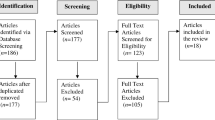Abstract
The effects of observing an adult emitting tacts on children’s rate of uninstructed (i.e., “spontaneous”) tacts were examined in three children diagnosed with autism. Each participant was exposed to two conditions in four settings each: in condition 1, participants received 20 trials of teacher-initiated interactions in which the child was asked to tact 20 objects during 5 min. Condition 2 was identical to condition 1 except that the teacher also tacted 20 objects interspersed with the 20 tact trials. The number of uninstructed tacts was recorded in both conditions. Children emitted between 1.58 and 2.68 times more uninstructed tacts in condition 2 than in condition 1. These results indicate that teachers’ emission of tacts increases the emission of uninstructed tacts in children with autism.

Similar content being viewed by others
References
Baer, D. M., Peterson, R. F., & Sherman, J. A. (1967). The development of imitation by reinforcing behavioral similarity to a model. Journal of the Experimental Analysis of Behavior, 21, 405–416.
Catania, A. C. (1998). Learning. Prentice Hall: Upple Saddle River, New Jersey.
Greer, R. D., Dudek-Singer, J., & Gautreaux, G. (2006). Observational learning. International Journal of Psychology, 41, 486–499.
Greer, R. D., McCorkle, N., & Williams, G. (1989). A sustained analysis of the behaviors of schooling. Behavioral Residential Treatment, 4, 113–141.
Greer, R. D., & Ross, D. E. (2008). Verbal behavior analysis: Inducing and expanding new verbal capabilities in children with language delays. New York: Pearson.
Greer, R. D., & Speckman, J. (2009). The integration of speaker and listener responses: a theory of verbal development. The Psychological Record, 59, 449–488.
Hart, B., & Risley, T. R. (1975). Incidental teaching of language in the preschool. Journal of Applied Behavior Analysis, 8, 411–420.
Hart, B., & Risley, T. R. (1996). Meaningful differences in the everyday life of America’s children. NY: Paul Brookes.
Horne, P. J., & Lowe, C. F. (1996). On the origins of naming and other symbolic behavior. Journal of the Experimental Analysis of Behavior, 65, 185–241.
Koegel, R. L., O’Dell, M. C., & Koegel, L. K. (1987). A natural language teaching paradigm for nonverbal autistic children. Journal of Autism and Developmental Disorders, 17, 187–200.
Krantz, P. J., & McClannahan, L. E. (1998). Social interaction skills for children with autism: a script-fading procedure for beginning readers. Journal of Applied Behavior Analysis, 31, 191–202.
Lydon, H., Healy, O., Leader, G., & Keohane, D. D. (2008). The effects of intensive tact instruction on three verbal operants in non-instructional settings by two children with autism (pp. 35–46). Special Issue: Journal of Speech-Language Pathology and Applied Behavior Analysis.
McGee, G. G., Krantz, P. J., & McClannahan, L. E. (1985). The facilitative effects of incidental teaching on preposition use by autistic children. Journal of Applied Behavior Analysis, 18, 17–31.
Pereira-Delgado, J. A., & Oblak, M. (2007). The effects of daily intensive tact instruction on the emission of pure mands and tacts in non-instructional settings by three pre school children with developmental delays. Journal of Early and Intensive Behavior Interventions, 4, 392–411.
Pereira-Delgado, J. A., Greer, R. D., & Speckman-Collins, J. (2006). The effects of using a mirror to induce generalized imitation. Paper presented as part of a symposium at the thirty-second annual convention of the Association for Applied Behavior Analysis International. GA: Atlanta.
Pistoljevic, N. (2008). The effects of multiple exemplar instruction and intensive tact instructional histories on the acquisition of naming in preschoolers. Columbia University Graduate School of Arts and Sciences: Unpublished dissertation.
Pistoljevic, N., & Greer, R. D. (2006). The effects of daily intensive tact instruction on preschool students’ emission of pure tacts and mands in non-instructional setting. Journal of Early and Intensive Behavior Interventions, 1, 103–120.
Ross, D. E., Singer-Dudek, J., & Greer, R. D. (2005). The teacher performance rate accuracy scale (TPRA): training as evaluation. Education and Training in Developmental Disabilities, 40, 411–423.
Schauffler, G., & Greer, R. D. (2006). The effects of intensive tact instruction on audience accurate tacts and conversational units. Journal of Early and Intensive Behavioral Interventions, 3, 120–132.
Skinner, B. F. (1957). Verbal behavior. Englewood, NJ: Prentice Hall.
Williams, G., Carnerero, J. J., & Pérez-González, L. A. (2006). Generalization of tacting actions in children with autism. Journal of Applied Behavior Analysis, 39, 233–237.
Williams, G., & Greer, R. D. (1993). A comparison of verbal-behavior and linguistic-communication curricula for training developmentally delayed adolescents to acquire and maintain vocal speech. Behaviorology, 1, 31–46.
Acknowledgments
This research was supported by grants SEJ2006-08055, of the Ministerio de Ciencia y Tecnología, and PSI2009-08644, of the Ministerio de Ciencia e Innovación, Spain. The authors acknowledge the help of the teachers of Al-Mudarïs that participated in the study, the English editors Cecilia Ortiz Torres and Maribel Ruiz Canales, and the collaboration of the Bubba Park and Piedra supermarket.
Author information
Authors and Affiliations
Corresponding author
Rights and permissions
About this article
Cite this article
Pérez-González, L.A., Pastor, A. & Carnerero, J.J. Observing Tacting Increases Uninstructed Tacts in Children with Autism. Analysis Verbal Behav 30, 62–68 (2014). https://doi.org/10.1007/s40616-013-0003-6
Published:
Issue Date:
DOI: https://doi.org/10.1007/s40616-013-0003-6




